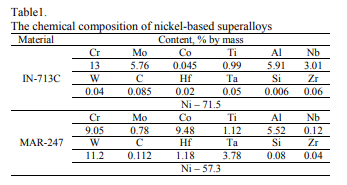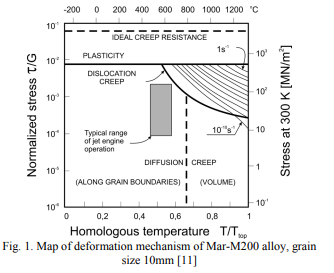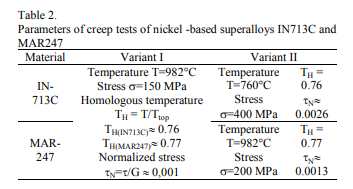1. Introduction
One of the main problems in the technology of casting heat resistant nickel alloys is the ability to shape their structure, providing the desired casting properties. Combination of creep strength, endurance under thermo - mechanical fatigue and plasticity of nickel-based superalloys, optimized for specific applications in aviation gas turbines can be achieved for example by a suitable selection of size, orientation and uniformity of grains.
Creep-rupture strength of nickel-based superalloys increases along with the grain size under certain conditions of heat and mechanical loads. In many cases, however yield strength and tensile strength decreases. Moreover, fine-grained structure of castings are characterized by a higher speed of steady creep [1-4].
Therefore, it is reasonable to master the ability to control the shaping of the original structure of these alloys, adequate to the working conditions of the items produced. Methods for controlling grain size of the cast heat-resistant nickel alloys include mainly; modification of the surface, subjecting a solidifying alloy to mechanical factors and volumetric modification of a liquid alloy by introducing appropriate additives, heterogeneous nucleants [5-7]. In the literature, there is a lot of information about the microstructure refinement of nickel superalloys using a refining method [8]and modifying with micro additives [9-10].
The study consisted in assessing the influence of surface and volume modification and double filtration during pouring the moulds on the stability under accelerated creep of castings made of waste products of nickel-based superalloys IN-713C and the MAR-247. The influence of the size of micrograin on the characteristics of high-temperature creep under the conditions of two variants of the study was analysed. Creep characteristics of variant I were obtained on the basis of previous studies of these alloys with the parameters T=982°C, σ=150MPa [1].Variant II included carrying out alloy creep tests of IN713C with the parameters T=760°C, σ= 400MPa and alloy MAR247 with the parameters T=982°C, σ=200MPa. The studies simulated destruction processes observed in the extreme conditions most strenuous parts of turbine engines. Conditions for the formation and growth of the cracks in the samples, taking into account the stereological characteristics of macro-and microstructure of materials, were analysed. Results of laboratory tests allow an initial assessment of the suitability of different technologies of modifying nickel-based superalloys for specific applications in aviation gas turbines.
2. Material and research methodology Four groups of threaded samples with dimensions (M12, do=6,0 mm lo = 32mm) were prepared. Samples for mechanical testing of macro- and microstructure were made of castings for which a starting batch material was waste from nickel-based superalloy IN-713C and the MAR-247 with the chemical composition showed in the Table 1.

Castings were obtained as a result of the following four casting experiments:
1. Cast IN-713C, (a form of blue, blue filter)
2. Cast IN-713C, (a form of white, blue filter)
3. Cast MAR-247, (a form of blue, blue filter)
4. Cast MAR-247, (a form of white, blue filter)
The process of smelting waste products in the crucible of Al2O3, and then casting was conducted in a vacuum induction furnace type IS 5/III, by Leybold–Heraeus. Experiment 2 and 4 included shaping a macrostructure of materials solely under the procedure of volume modification. While experiment 1 and 3 under the conditions of combined modification, so called surface and volume modification.
Total procedure of surface and volume modification required the application of so-called "blue" form (with a modifying coating-CoAl2O4) and placing additional filter containing also a cobalt aluminate in the runner dish. An additional result of the solution was a double filtration of the alloy.
Creep tests were conducted under conditions corresponding to the operating conditions of turbine blades of aircraft engines. Different test parameters were used including the parameters corresponding to the acceptance tests used in WSK Rzeszów compatible with Technological report cards for a given superalloy (for IN713C: T=982°C, σ=150MPa, for Mar247: T=982°C, σ=200MPa). Creep tests were performed on the machine WalterBai AG LFMZ-30kN. The study was conducted with the parameters listed in Table. 1. Table 1 lists also the parameters which determine the deformation mechanisms of this group of alloys (Fig. 1), [11, 12],so called normalized stress τN=τ/G and homologous temperature TH=T/Ttop. Variation of creep test parameters (Table 1) was designed to obtain information about the influence of grain size on the creep characteristics of the material. The knowledge in this field will allow shaping a macrostructure of cast components in the foundry processes in a rational way, depending on the applications in aviation turbine engine. Important determinants of the characteristics of the casting macrostructure are primarily the conditions of their thermo-mechanical loads.



